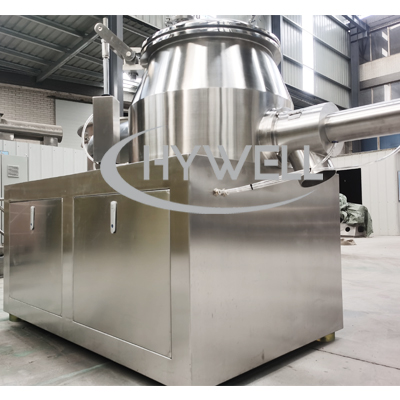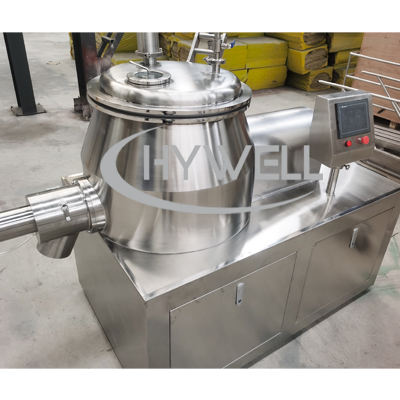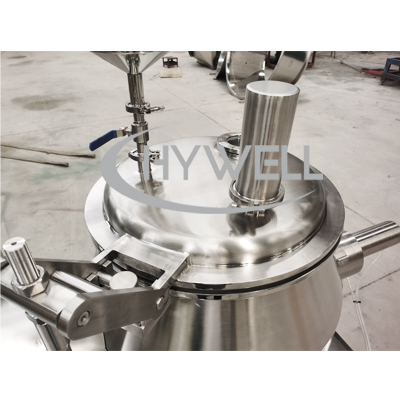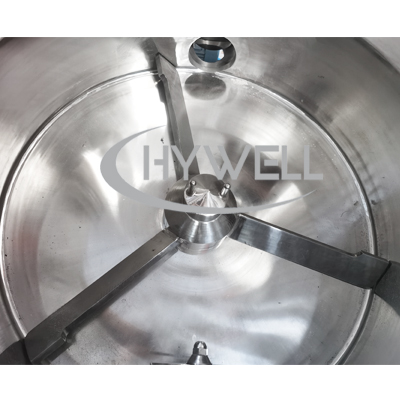Introduction
Wet granulation is a crucial step in the manufacturing of pharmaceutical tablets, where it improves the flowability, compressibility, and content uniformity of the granules. The process involves the addition of a liquid binder to the powder mixture, which creates cohesive granules through a combination of mechanisms such as agglomeration, coalescence, and consolidation. High shear granulation, also known as high shear mixer granulation, or rapid mixer granulation is a widely used method that provides excellent control over granule size, density, and uniformity.
What is Wet Granulation?
Wet granulation is a process that converts fine powders into granules with improved flow properties and compressibility. The process typically involves four key steps: powder mixing, binder addition, wet massing, and drying. During powder mixing, the active pharmaceutical ingredient (API), excipients, and other powders are blended to ensure a homogeneous mixture. The liquid binder is then added to the powder blend, and the wet mass is formed by agitating the mixture. Finally, the wet granules are dried, sieved, and milled to obtain the desired particle size distribution.
High Shear Granulation by High Shear Granulator Machine Video
Importance of Wet Granulation
Wet granulation offers numerous advantages in the pharmaceutical industry. Firstly, it improves the flowability of powders, making them easier to handle during subsequent processing steps such as tableting. Secondly, it enhances compressibility, allowing for the production of tablets with consistent hardness and dosage uniformity. Additionally, wet granulation can improve chemical stability, mask unpleasant tastes or odors, and modify drug release properties. These benefits make wet granulation a preferred choice for formulating solid dosage forms.
High Shear Granulators: An Overview
High shear granulators are specialized equipment used for wet granulation. They consist of a mixing bowl or a granulation chamber equipped with a high-speed impeller and chopper blades. The impeller generates intense mechanical forces that break down agglomerates and promote the formation of granules. High shear granulators are available in different designs, including top-driven and bottom-driven models, each offering distinct advantages based on the process requirements.
Advantages of High Shear Granulators
High shear granulators offer several advantages over other granulation techniques. Firstly, they provide excellent control over granule properties such as size, density, and porosity. This control allows for the production of granules with desired characteristics, such as improved flowability and compressibility. Secondly, high shear mixer granulators offer a high degree of process reproducibility, ensuring consistency in the quality of the granules produced. The equipment's efficient mixing action results in uniform distribution of the binder throughout the powder blend, leading to uniform granule formation. Additionally, high-shear granulators can handle a wide range of formulations, including those with challenging materials or high drug loads, making them versatile for various applications in the pharmaceutical industry.

High shear granulation

High shear granulator

High shear mixer granulator
Working Principle of High Shear Granulators
High shear granulators operate on the principle of mechanical agitation and shear forces. The impeller or chopper blades rotate at high speeds, creating a powerful turbulent flow within the granulation chamber. This turbulent flow induces collision and attrition between the particles, breaking them down and promoting their adhesion. The liquid binder, typically added through a spray system, wets the particles and acts as a binding agent. The combination of mechanical agitation and liquid binder results in the formation of cohesive granules.
Key Components of High Shear Granulators
High shear granulators consist of several key components that contribute to their efficient operation. The mixing bowl or granulation chamber is where the granulation process takes place. It is equipped with an impeller and chopper blades that generate the necessary shear forces. The impeller is driven by a motor, and its speed can be adjusted to control the intensity of mixing. The spray system, comprising a binder solution reservoir and a nozzle, facilitates the controlled addition of the liquid binder. Additionally, high shear granulators may include features such as temperature control, and automated controls for enhanced process control and monitoring.
Process Parameters in Wet Granulation
To achieve optimal granulation results, several process parameters need to be carefully controlled. These parameters include the impeller speed, binder addition rate, mixing time, granulation temperature, and granulation endpoint. The impeller speed affects the intensity of mixing and shear forces applied to the powder blend. The binder addition rate should be optimized to ensure uniform distribution without over-wetting or under-wetting the mixture. The mixing time should be sufficient to achieve the desired granule size and uniformity. The granulation temperature is crucial for thermosensitive materials, as excessive heat can degrade the API or excipients. Lastly, the granulation endpoint, determined by visual inspection or measurement of granule properties, indicates when the desired granule size and consistency have been achieved.
Formulation Considerations for Wet Granulation
When formulating for wet granulation, several factors should be taken into account. The selection of excipients and their compatibility with the API and binder is crucial for achieving robust granules. Excipients with appropriate binding, disintegrating, and flow-enhancing properties are commonly used. The choice of binder depends on the desired characteristics of the granules and the process requirements. Common binders include water, alcohol-based solutions, and polymers. The binder concentration and viscosity should be optimized to achieve the desired granule properties. Additionally, the particle size distribution of the starting powders, along with the use of appropriate granulating aids, can impact the granule formation process.
Granule Characterization and Evaluation
Granule characterization is essential to assess the quality and performance of the granules produced. Various parameters are evaluated, including granule size distribution, density, flowability, compressibility, and moisture content. Granule size distribution is typically determined using sieve analysis or laser diffraction techniques. Granule density affects the tablet's weight and disintegration properties. Flowability determines the ability of the granules to flow uniformly during tablet compression. Compressibility refers to the ability of the granules to withstand compression forces without excessive fragmentation or sticking. Moisture content is critical for stability and can affect the mechanical properties of the granules. These parameters are evaluated through appropriate analytical techniques and compared against predetermined specifications to ensure the granules meet the desired quality standards.

Spray Liquid

Impeller system

Chopper system
Troubleshooting in Wet Granulation
During wet granulation, various challenges and issues may arise that require troubleshooting. One common problem is the formation of oversized or undersized granules, which can affect tablet uniformity and content uniformity. This issue may be resolved by adjusting the impeller speed, binder addition rate, or mixing time. Another challenge is the presence of lumps or agglomerates in the granules, which can lead to tablet defects or clogging of equipment. Increasing the intensity of mixing or using appropriate granulating aids can help overcome this issue. Additionally, poor flowability or excessive moisture content can impact the downstream processing steps. Adjusting the granulation parameters or implementing drying techniques can address these issues.
Common Challenges in Wet Granulation
Wet granulation is a complex process, and several challenges are commonly encountered. One such challenge is the potential for API degradation or instability during the granulation process. This can be mitigated by optimizing the granulation temperature, selecting appropriate excipients, and minimizing exposure to moisture or oxygen. Another challenge is the control of granule size distribution, as achieving a narrow range of particle sizes can be difficult. By optimizing the formulation and process parameters, including binder concentration and impeller speed, granule size control can be improved. Additionally, the selection of suitable binder materials and their compatibility with the formulation components is crucial for successful granulation.
Quality Assurance in Wet Granulation
Quality assurance plays a vital role in ensuring the production of high-quality granules. This involves the implementation of robust procedures, adherence to regulatory guidelines, and thorough documentation of the granulation process. Quality control tests are performed at various stages to assess the physical and chemical properties of the granules. In-process checks, such as monitoring granule moisture content and particle size distribution, help identify any deviations and allow for corrective actions. Final product testing, including content uniformity, dissolution, and stability studies, ensures that the granules meet the required specifications. Additionally, proper cleaning and maintenance of equipment are essential to prevent cross-contamination and ensure product safety.
Comparison with Other Granulation Techniques
While wet granulation with high-shear granulators is widely utilized, it is important to compare it with other granulation techniques. Dry granulation, for instance, eliminates the use of liquid binders and involves the compaction of powders into granules using pressure. This technique is suitable for moisture-sensitive or heat-sensitive materials but may result in lower granule density and flowability compared to wet granulation. Fluidized bed granulation, on the other hand, involves suspending the powder particles in an air stream and spraying a binder solution onto them. It offers advantages such as efficient mixing and drying capabilities but may have limitations in terms of controlling granule size and density. The choice of granulation technique depends on the specific requirements of the formulation and the desired characteristics of the granules.
High Shear Granulation Video
Future Trends and Innovations in Wet Granulation
The field of wet granulation is continuously evolving, with ongoing research and technological advancements driving innovation. One area of focus is the development of continuous wet granulation processes, which offer advantages such as reduced processing time, improved efficiency, and enhanced control over granule properties. Continuous manufacturing enables real-time monitoring and adjustment of process parameters, resulting in increased productivity and reduced variability. Furthermore, the integration of process analytical technology (PAT) tools, such as near-infrared spectroscopy and acoustic emission monitoring, allows for in-line monitoring and control of critical parameters. These advancements contribute to the optimization of wet granulation processes, leading to improved product quality, reduced costs, and enhanced process understanding.
Another area of interest in wet granulation is the development of novel binder materials with improved functionality. Researchers are exploring the use of polymers, copolymers, and excipients with unique binding properties to enhance the performance of granules. These materials can provide better control over granule strength, disintegration, and drug release profiles. Additionally, efforts are being made to develop eco-friendly and sustainable binder options to reduce environmental impact.
Incorporating process modeling and simulation techniques is another trend in wet granulation. By utilizing computational tools, researchers and manufacturers can optimize process parameters, predict granule properties, and troubleshoot potential issues before conducting experimental trials. This approach saves time and resources while allowing for a deeper understanding of the granulation process.
Furthermore, the integration of automation and robotics in wet granulation processes is gaining traction. Automated systems can precisely control the addition of binders, monitor process parameters, and streamline the overall production workflow. This not only improves process efficiency but also reduces the risk of human error and variability.
In conclusion, wet granulation with high-shear granulators is a versatile and effective technique for the production of granules in various industries. It offers advantages such as improved flowability, compressibility, and content uniformity. By carefully controlling process parameters, selecting suitable formulations, and implementing quality assurance measures, high-quality granules can be consistently produced. Ongoing advancements in the field, including continuous manufacturing, novel binder materials, process modeling, and automation, are shaping the future of wet granulation. These developments aim to further optimize the process, enhance product quality, and improve sustainability.
High Shear Mixer Granulator Video
FAQs
Q1: Can wet granulation be used for all types of formulations?
A1: Wet granulation is suitable for a wide range of formulations, including both hydrophilic and hydrophobic drugs. However, certain formulations may require modifications or alternative granulation techniques depending on their specific characteristics.
Q2: How long does the wet granulation process typically take?
A2: The duration of the wet granulation process can vary depending on factors such as formulation complexity, desired granule properties, and equipment used. Typically, the process can take several hours, including mixing, wet massing, and drying stages.
Q3: What are some common challenges faced during wet granulation?
A3: Common challenges in wet granulation include achieving desired granule size distribution, controlling moisture content, minimizing agglomeration or lumps, and maintaining consistent granule properties. These challenges can be addressed through process optimization and troubleshooting techniques.
Q4: Is wet granulation a scalable process for large-scale production?
A4: Wet granulation is a scalable process and can be successfully implemented for large-scale production. However, factors such as equipment selection, process validation, and quality control measures should be considered to ensure consistent and reproducible results.
Q5: Are there any alternatives to wet granulation for granule formation?
A5: Yes, alternative granulation techniques include dry granulation and fluidized bed granulation. These techniques offer specific advantages and may be preferred for certain formulations or process requirements. The choice of granulation technique depends on the desired characteristics of the granules and the specific needs of the application.
Order of GHL series High Shear Granulator Description
The Vietnam old customer of Hywell Machinery Co., Ltd. placed an order to purchase the GHL series high shear granulator again in early 2022, and the client purchased Hywell 's GHL series wet granulator many sets. This GHL-200 high shear mixer granulator completes production according to the contract requirements. The customer can't do FAT at Hywell factory before delivery .,and the FAT is done by the remote video of our engineer and customer. This high shear granulation is fully packaged and ready to delivery.
the GHL series high-shear granulation often connect with YK series oscillating granulator to get 1.5-5mm wet granules, and then direct to send the wet granules into the drying machine to get dried granules (instant granules), the drying machine can use Vertical Fluid Bed Dryer or Horizontal Fluid Bed Dryer, but it decide by the treating capacity. The final step of the process system is the granules sifter. The granules sifter will separate the large powder particles from the powder, size is determined for the separation. The off size is bagged off and the powder can be either directly packed into big bags or conveyed to a silo system for other packing systems.
The rapid mixing granulator using high-shear granulator can be divided into 5 stages and they included;
1. Different kinds powder mixing
2. Binder addition or addition of granulating liquid.
3. Wetting of powder and nucleation
4. Growth of granules and densification of the powder.
5. Granule attrition and breakage.
English
Русский
العربية
Français
Español
Português
Deutsch
italiano
日本語
한국어
Nederlands
Tiếng Việt
ไทย
Polski
Türkçe
ພາສາລາວ
Bahasa Melayu
Filipino
Bahasa Indonesia
magyar
Română
Čeština
қазақ
Српски
हिन्दी
فارسی
Slovenčina
Slovenščina
Norsk
Svenska
українська
Ελληνικά
Suomi
Հայերեն
עברית
Dansk
اردو
বাংলা
Hrvatski
Afrikaans
Gaeilge
Eesti keel
Māori
नेपाली
Oʻzbekcha
latviešu
Azərbaycan dili
Беларуская мова
Български
ქართული
Kurdî
Кыргызча

 简体中文
简体中文









